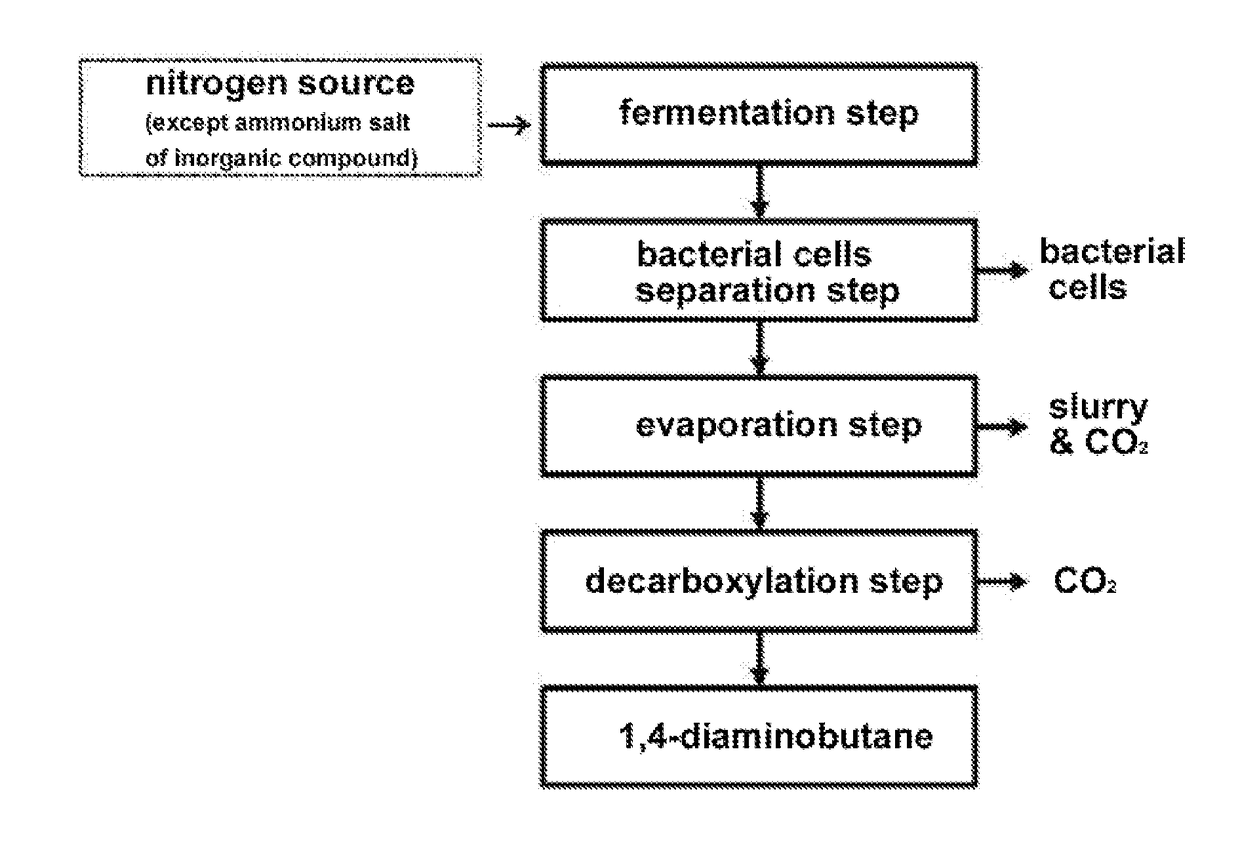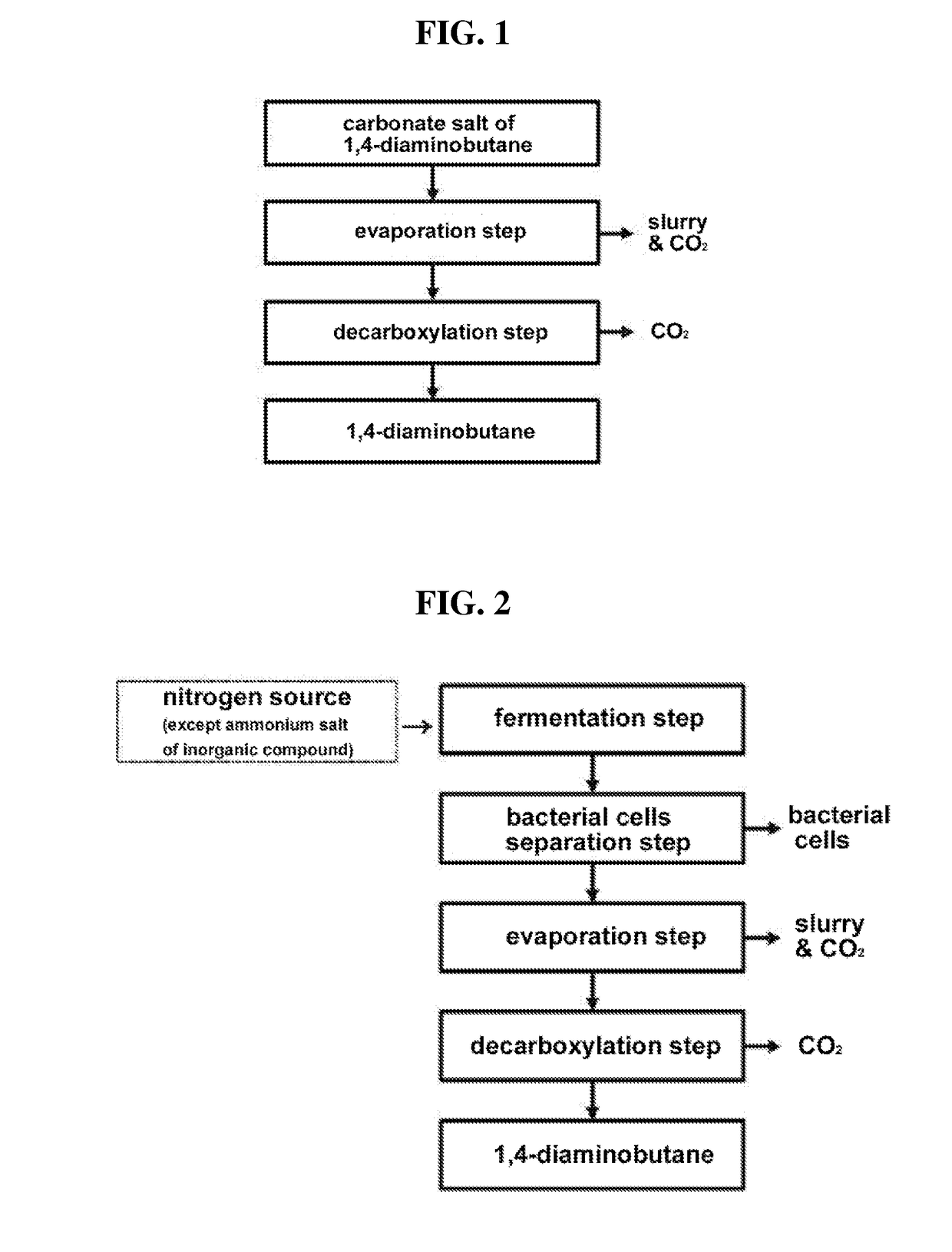Method for purifying 1,4-diaminobutane
a technology of diaminobutane and purification method, which is applied in the field of refining 1, 4diaminobutane, can solve the problems of adding purification process, achieve the effect of reducing the consumption of an alkali compound required in the purification method, high yield and convenient obtained
- Summary
- Abstract
- Description
- Claims
- Application Information
AI Technical Summary
Benefits of technology
Problems solved by technology
Method used
Image
Examples
example 1
nobutane Purifying Method Using NH3 without Removing Bacterial Cells
[0098](Fermentation Step)
[0099]1) Spawn Culture: Spawn Culture of Bacteria Producing 1,4-Diaminobutane
[0100]400 mL of a medium containing 30.0 g / L of glucose, 15 g / L of molasses, 1.11 g / L of phosphoric acid, 5.8 g / L of magnesium sulfate 7 hydrate, 10.0 g / L of corn steep liquor, 0.5 g / L of arginine, 1.0 mg / L of biotin, 20.0 mg / L of thiamine pyrophosphate, 20.0 mg / L of calcium pathothenate, 20.0 mg / L of nicotinic acid, and 0.2 g / L of anti-foaming agent was added to a 1 L-glass fermenter and heated to main a temperature of 120° C. for 20 minutes to perform sterilization.
[0101]The sterilized fermenter was cooled to a temperature of 30° C., bacterial cells, i.e., Corynebacterium KCCM11401P (Korean Patent No. 2014-0115244) pre-grown on a cornmeal malt extract agar (CMA) solid medium for 12 hours were inoculated into the medium, and the bacterial cells were cultured with sufficient air circulation and stirring process at 3...
example 2
nobutane Purifying Method Using NH3 after Removing Bacterial Cells
[0113](Fermentation Step)
[0114]A fermented broth was prepared by performing a spawn culture and a main culture in the same manner as in Example 1.
[0115](Bacterial Cells Separation Step)
[0116]13,400 g of the fermented broth was added to a 15 L-basket, and the fermented broth was filtered by using a membrane filter (Pellicon 2, a pore size: 0.1 μm, a membrane area: 0.5 m2, available from Milipore) in the form of a cartridge.
[0117]The fermented broth was added to the membrane filter, 400.0 g of a sludge of bacterial cells was separated and removed under conditions including a temperature of 60° C. and a transmembrane pressure (TMP) of 1.2 atm, and an amount of the filtrate thus obtained was 13,000 g. Table 4 is a component analysis table before and after separating bacterial cells.
TABLE 4FermentedSludge ofbrothbacterial cellsFiltrateComponent(g)(g)(g)pH8.08.08.0Water12,285.1293.611,991.61,4-Diaminobutane0.00.00.01,4-Diam...
example 3
nobutane Purifying Method Using NH3 without Concentration after Removing Bacterial Cells
[0124](Fermentation Step)
[0125]A fermented broth was prepared by performing a spawn culture and a main culture in the same manner as in Example 1.
[0126](Bacterial Cells Separation Step)
[0127]A bacterial cells separation step was performed in the same manner as in Example 2.
[0128](Distillation Step)
[0129]A distillation step was performed in the same manner as in Example 1, except that the filtrate, from which bacterial cells were separated, was used. 6,500 g of the filtrate was added to obtain 6,465.7 g of the condensate and 34.3 g of the residue. Table 8 is a component analysis table before and after the distillation step.
TABLE 8Residue afterEvaporatedConcentrateevaporationcondensateComponent(g)(g)(g)pH8.0—10.8Water5,995.814.06,000.31,4-Diaminobutane0.07.30.01,4-Diaminobutane484.00.0465.4bicarbonate1,4-Diaminobutane0.00.00.0carbonateIons7.30.00.0Amino acid5.45.40.0Organic acid6.06.00.0Protein1.51...
PUM
| Property | Measurement | Unit |
|---|---|---|
| pressure | aaaaa | aaaaa |
| vapor temperature | aaaaa | aaaaa |
| vapor temperature | aaaaa | aaaaa |
Abstract
Description
Claims
Application Information
 Login to View More
Login to View More - R&D Engineer
- R&D Manager
- IP Professional
- Industry Leading Data Capabilities
- Powerful AI technology
- Patent DNA Extraction
Browse by: Latest US Patents, China's latest patents, Technical Efficacy Thesaurus, Application Domain, Technology Topic, Popular Technical Reports.
© 2024 PatSnap. All rights reserved.Legal|Privacy policy|Modern Slavery Act Transparency Statement|Sitemap|About US| Contact US: help@patsnap.com









